
Emerald Bay, Lake Tahoe, California, USA
Lake Tahoe, altitude 6,225 feet, straddles the California-Nevada border in the dramatic Sierra Nevada mountains. The largest alpine lake in the USA, it is a sparkling jewel ringed by rugged peaks.
The Sierra Nevada mountains are special to me, as I have spent much time rock climbing in Yosemite Valley and hiking in this area.
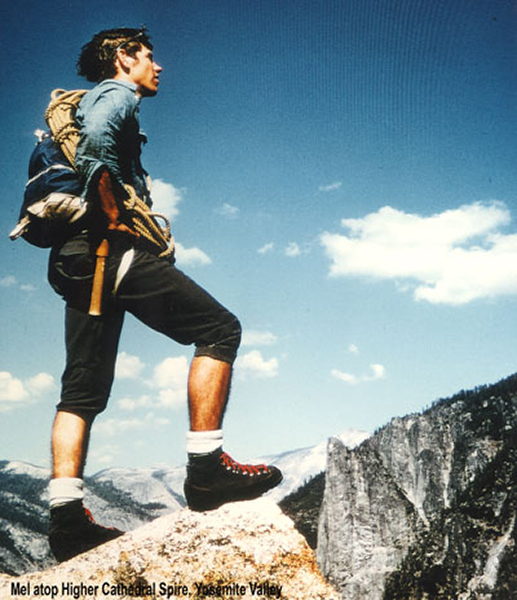
On the first week of October in 1975, Judy and I took our three young children backpacking to the Desolation Wilderness Area high above Lake Tahoe.
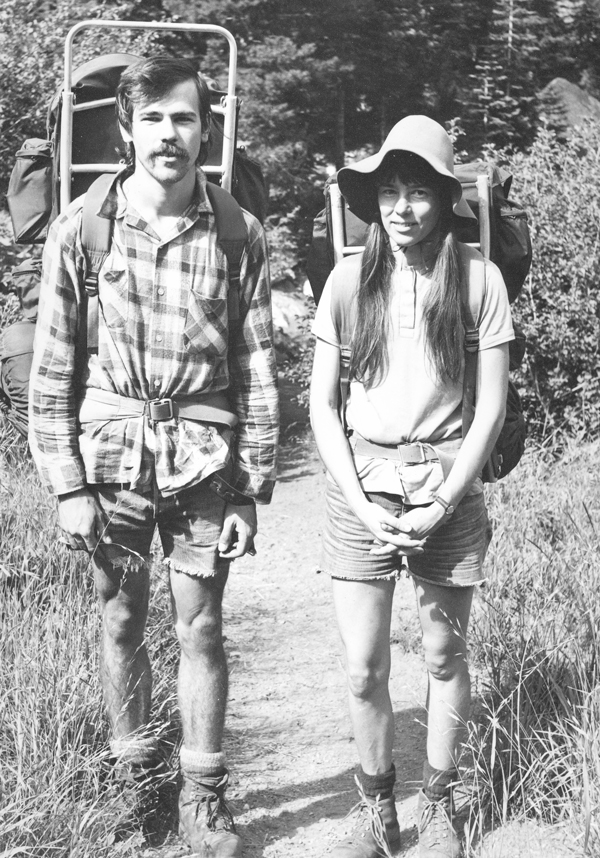
Overnight, we had the first snow of the season. It was beautiful, but as we were not geared up for winter camping, we headed back down that morning.
The winter of 2016-17 had a snowpack 160% of normal, and the snow has persisted into the summer. As of June 16th, 2017, the Tioga Pass road from Yosemite Valley via Tuolumne Meadows was still closed due to heavy snowpack. The mountains ringing Lake Tahoe were still heavy with snow.
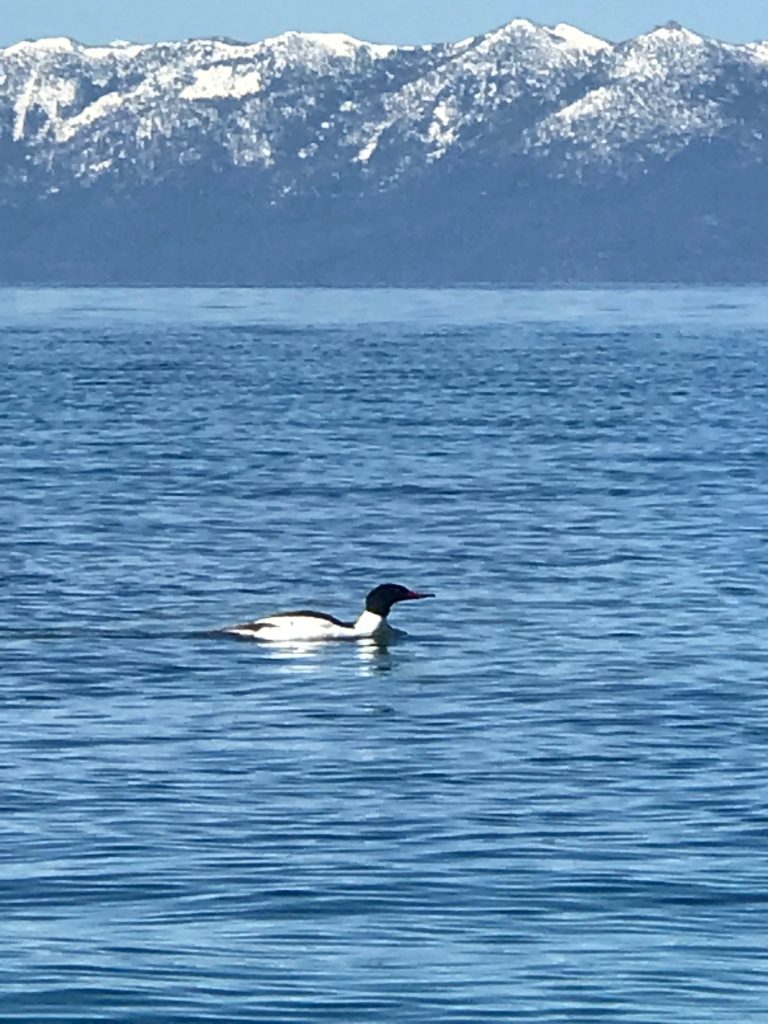
Merganser Duck, Lake Tahoe. –Lyndal Hubbard
I had hoped to hike and camp in the Desolation Wilderness and other high areas in June, but the heavy snowpack above 7500 feet elevation made that seem implausible.
To check out the actual conditions, my first hike was from Meeks Bay (6240 feet) to Crag Lake (7441 feet) in the Desolation Wilderness, a hike of about 10 miles round trip, with a climb of about 1300 feet total. For day hiking, you simply fill out a permit form at the trailhead (free) telling where you intend to hike, keep one part with you, and drop one part in the box.

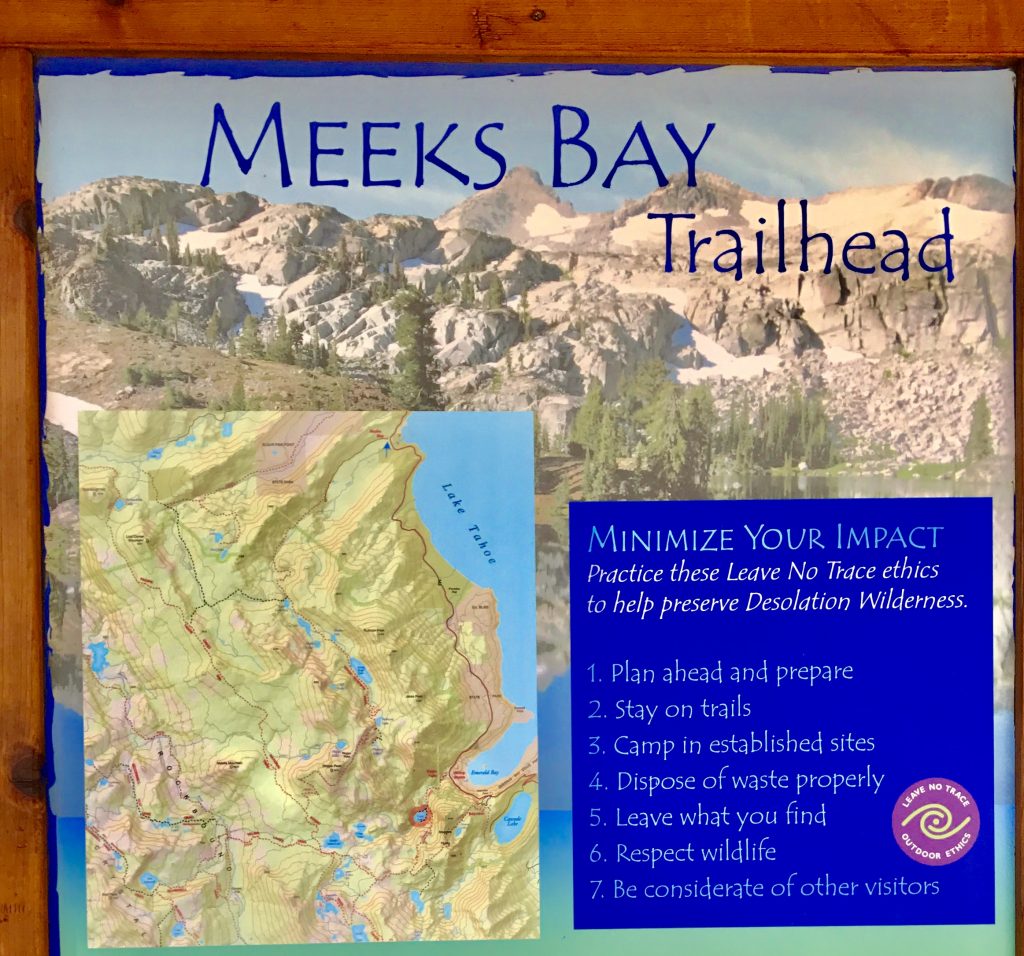
The trail begins up a valley, and is boggy in places. In the morning, there were lots of bugs–glad I packed my bug headnet. Further up, as it climbs the hill above Meeks Creek, it is mostly dry and bug-free. Most of the trail is a pleasant 10% grade without steps, which is easy on your knees. The trail could be hiked in athletic shoes, but the wet patches and snow make waterproof mountain boots a better choice.
The creek was in full flood, and the sound of the rapids is pleasant. At one point you must cross the wide creek on a log bridge, which was damaged by winter flooding: two of the logs are washed sideways, and one is partially broken. However, you can cross with care. The snow was packed and easy to walk on.

Meeks Creek, Lake Tahoe, California from Mel Malinowski on Vimeo.
[vc_row][vc_column][vc_masonry_media_grid grid_id=”vc_gid:1497668907357-b41051ec-d1da-10″ include=”6367,6361,6368,6369,6373,6370,6376,6377,6380,6378,6379,6382,6381,6384,6385,6389,6392,6397,6396,6395,6398,6391,6393″][/vc_column][/vc_row]
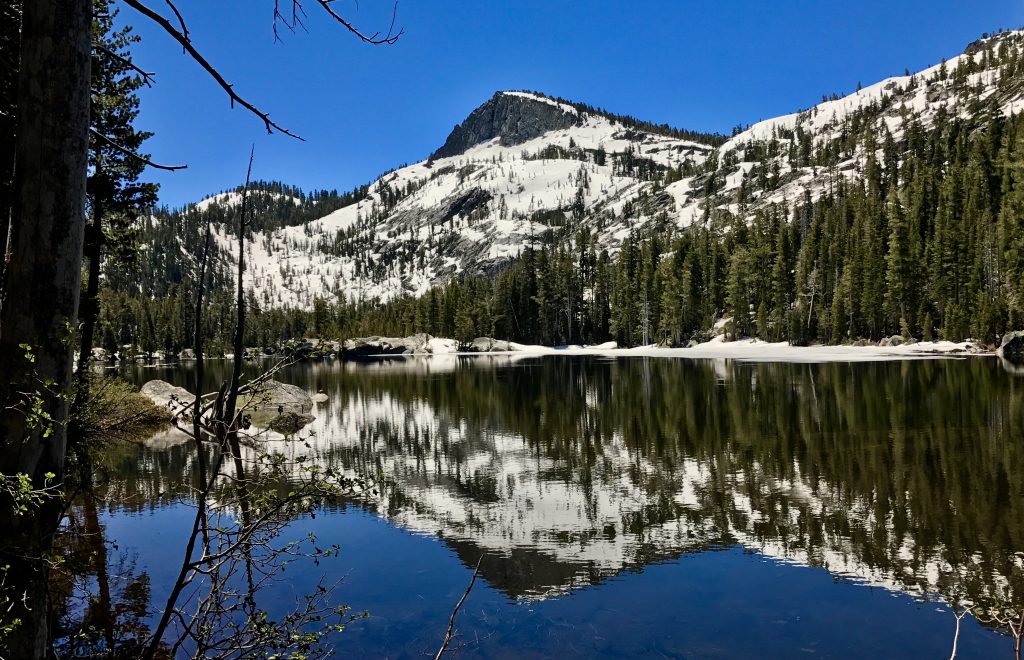
Crag Lake. There was still snow on the surface of the lake at the edges.
As it turns out, camping at Crag Lake is already possible, as there are many suitable areas for tents that have no snow cover. If I had come with my tent and gear, I could have stayed (assuming I had obtained a permit!) I wish that I had, as it is lovely, and I would have had it to myself.
I tried a side hike on the Lake Genevieve trail toward the Pacific Crest Trail, but after a mile, the snow coverage increased, and I decided that I did not have the time/range that day, so I turned back. My hike wound up 11 miles and 1750 feet of climb.
The Sierra Nevada has pristine and dramatic rock formations and towering trees that are among the finest in the world. I’m pleased to get back into the back country and see the mountains of my youth again.
Good reading: The Big Rock Candy Mountain by Wallace Stegner.
As I drank my morning coffee, a small brown bear ambled up to the door leading in from the patio, stood up, and tried to open the lever handle. Fortunately, the door was locked. Earlier this year, another (perhaps the same?) bear had opened this door, come in, cleaned out the refrigerator and generally made a mess. Since then, the doors are kept locked day and night!

This morning, I headed up on the old Donner Pass Road to Donner Summit, to try hiking the ‘Mount Judah Loop’ trail. The snowpack may prevent this.
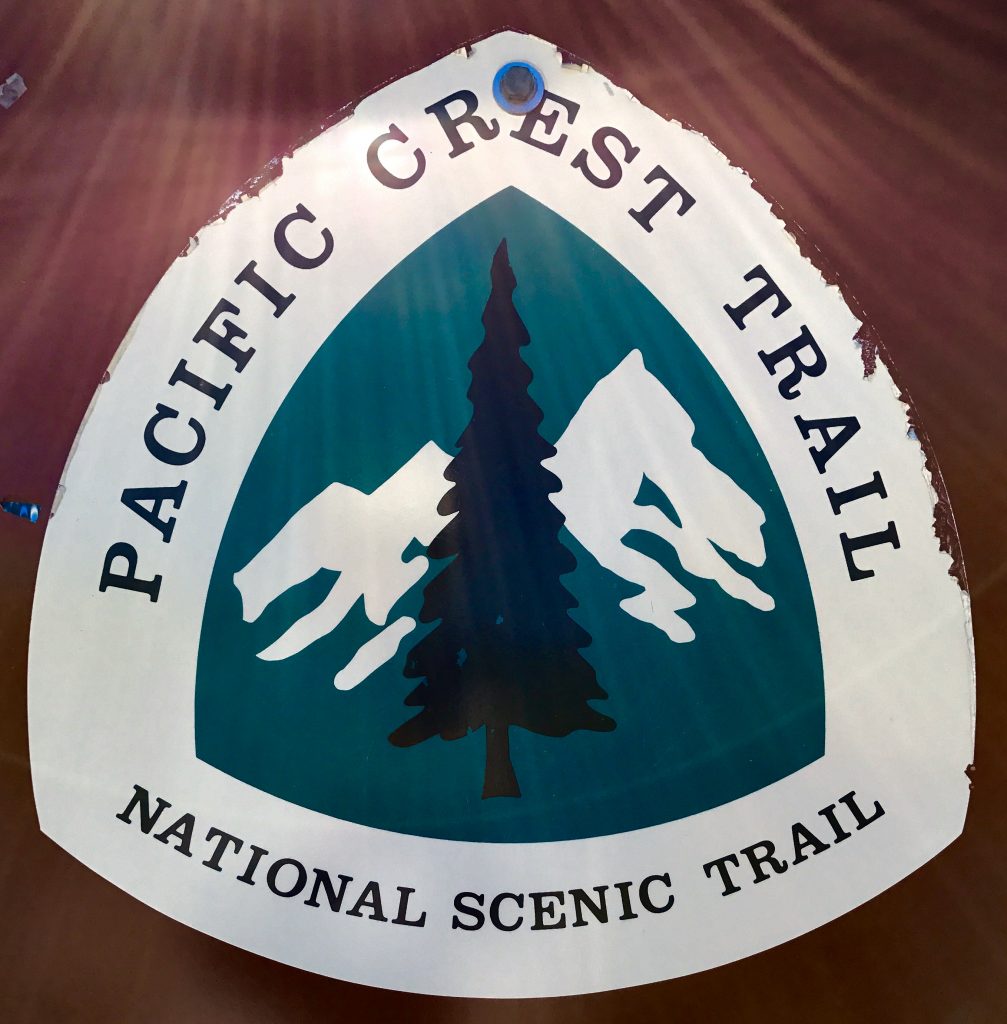
Much of this loop is on the Pacific Crest Trail, which stretches from Mexico to Canada. The scenery on the way is dramatic. On the mountainside across the way you can see the snowsheds built to protect the railroad tracks.
 Donner Lake
Donner Lake
[vc_row][vc_column][vc_masonry_media_grid grid_id=”vc_gid:1497830837927-af152fcb-2e30-2″ include=”6442,6436,6432,6431,6434,6433,6448,6446,6443,6435,6437,6441,6439,6438,6440,6444″][/vc_column][/vc_row]
Not far from the trailhead, a section of trail was covered by a long steep snowslope. Crossing such a slope, you really should have crampons (removable set of spikes) on your boots, and an ice axe in your hands, because if you start sliding, you likely will not be able to stop. When you do this on purpose, it is called glissading, and is great fun. Doing it by accident can kill you. In this case, you’d wind up catapulted onto a big rock pile at the bottom.
Some people had kicked boot notches in the slope, and by following these carefully (and improving them), I was able to cross.
Ahead, the trail was mostly free of snow, climbing gradually toward the winter ski slopes of Sugarbowl Ski resort.
Unfortunately, after about 1 ½ miles, the patches of snow became nearly continuous, and without GPS it would have been impossible to stay on the trail route. I picked up a 3′ piece of broken bamboo trail marker, and used it as a crude ice axe just in case. It became clear that the upper trail would not be much fun to follow like this, so I turned back. I doubt that anyone will do the complete PCT this season.
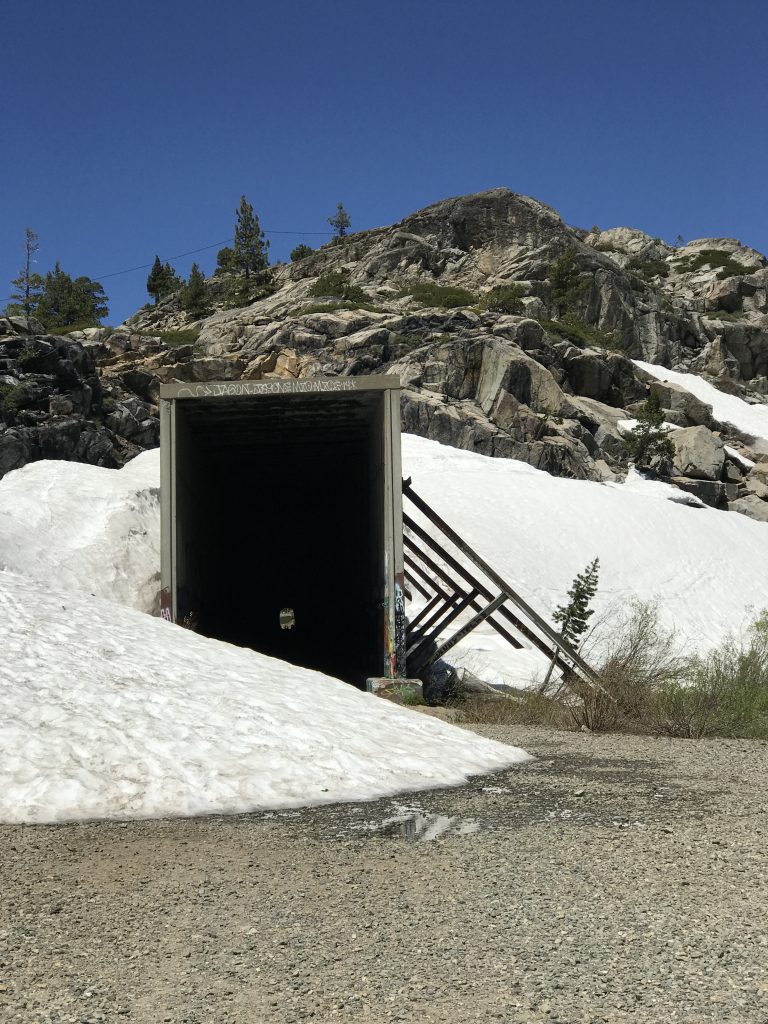
Near the trailhead there are some old abandoned original train tunnels that may be walked through, so I did. Blasting these through the granite mountains back in the 1800s was quite a feat.

Union Pacific Railroad tunnel
Instead of detailing every hike I did in the Lake Tahoe area, I will include some specifics of interest, as well as more photo collages of this marvelous, spectacularly beautiful area.
Today I went stand-up paddleboarding for the first time, on Lake Tahoe:
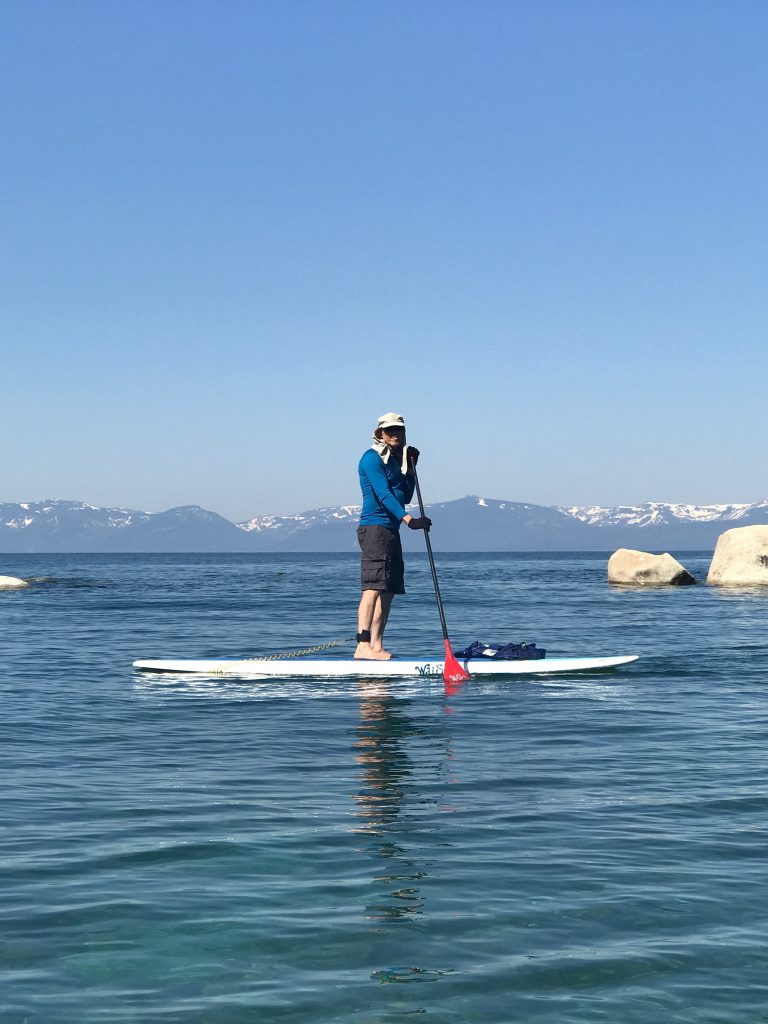
A dear hiking friend literally made me do this (against my protestations that I had come here to hike). I must admit that the cold waters of this snow-melt fed deep alpine lake gave me pause. However, the reality was much different than I expected. I have windsurfed, so standing up on a board was not a new skill. It takes a bit of balance, but is not very difficult.
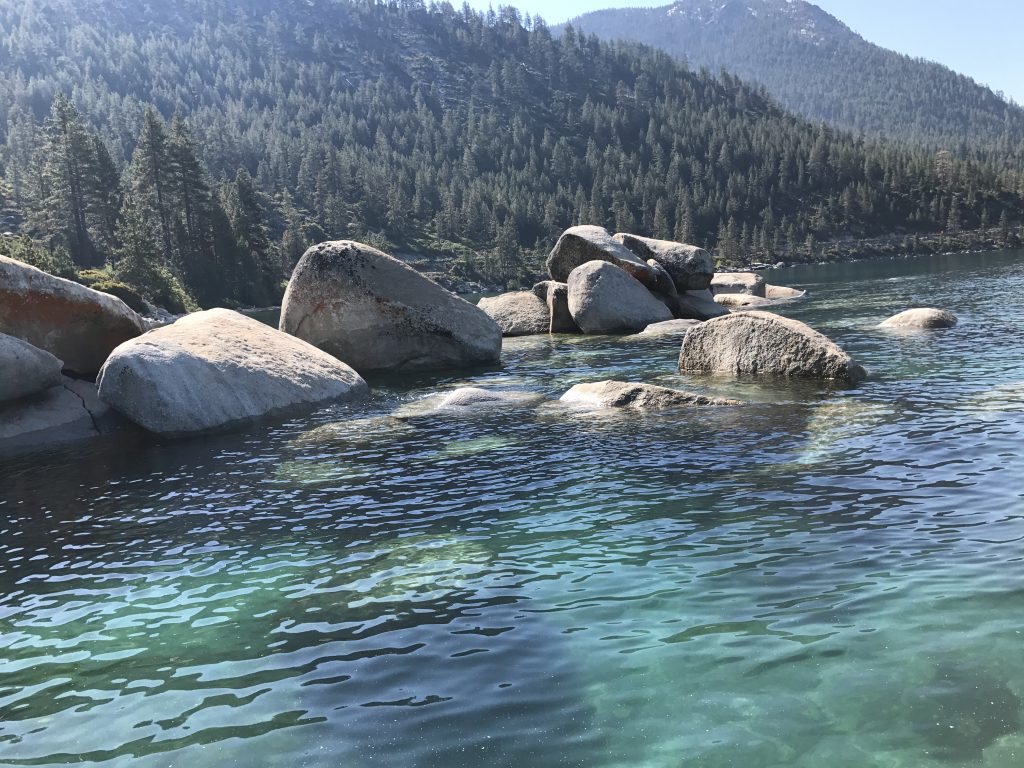
My initial thoughts were essentially “why do people spend hours doing this rather slow thing??” (of course, others may think this of the hiking I do so much of) Well, maybe because it is really beautiful and peaceful out there? I found paddleboarding to be a bit like meditation.
I still prefer hiking, but I now see the attraction, and may do it from time to time.
[vc_row][vc_column][vc_masonry_media_grid grid_id=”vc_gid:1498107143758-7a1b49ab-7129-0″ include=”6461,6462,6456,6455,6464,6459,6458,6457,6472,6474,6475,6476,6477,6482,6480,6481,6483,6478″][/vc_column][/vc_row]
I was a bit early for the prime wildflower season after this unusually heavy snow winter, but there were already many beautiful flowers to see.
[vc_row][vc_column][vc_masonry_media_grid grid_id=”vc_gid:1498667695005-ebca6c34-954b-9″ include=”6517,6516,6519,6520,6521,6514,6515,6522,6513,6512,6496,6511,6509,6507,6492,6508,6501,6497,6505,6506,6483,6495,6493,6494,6518,6502″][/vc_column][/vc_row]
This area is so dramatic that I wish I could stay a few more months. However, it is time to move on to another adventure.

Leave a Reply
You must be logged in to post a comment.